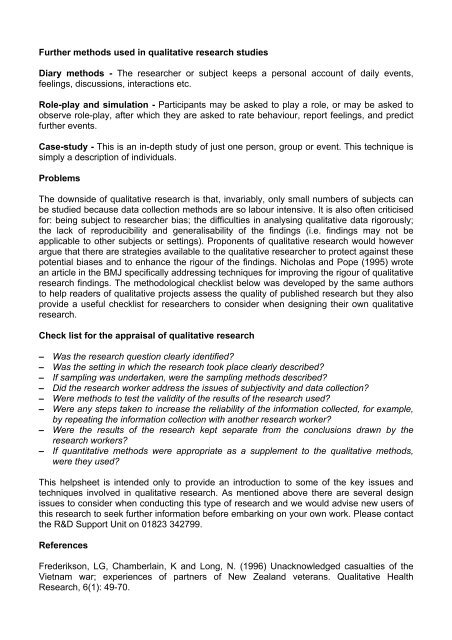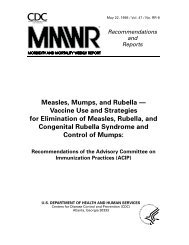QUALITATIVE RESEARCH METHODS - Chnri
QUALITATIVE RESEARCH METHODS - Chnri
QUALITATIVE RESEARCH METHODS - Chnri
You also want an ePaper? Increase the reach of your titles
YUMPU automatically turns print PDFs into web optimized ePapers that Google loves.
Further methods used in qualitative research studiesDiary methods - The researcher or subject keeps a personal account of daily events,feelings, discussions, interactions etc.Role-play and simulation - Participants may be asked to play a role, or may be asked toobserve role-play, after which they are asked to rate behaviour, report feelings, and predictfurther events.Case-study - This is an in-depth study of just one person, group or event. This technique issimply a description of individuals.ProblemsThe downside of qualitative research is that, invariably, only small numbers of subjects canbe studied because data collection methods are so labour intensive. It is also often criticisedfor: being subject to researcher bias; the difficulties in analysing qualitative data rigorously;the lack of reproducibility and generalisability of the findings (i.e. findings may not beapplicable to other subjects or settings). Proponents of qualitative research would howeverargue that there are strategies available to the qualitative researcher to protect against thesepotential biases and to enhance the rigour of the findings. Nicholas and Pope (1995) wrotean article in the BMJ specifically addressing techniques for improving the rigour of qualitativeresearch findings. The methodological checklist below was developed by the same authorsto help readers of qualitative projects assess the quality of published research but they alsoprovide a useful checklist for researchers to consider when designing their own qualitativeresearch.Check list for the appraisal of qualitative research– Was the research question clearly identified?– Was the setting in which the research took place clearly described?– If sampling was undertaken, were the sampling methods described?– Did the research worker address the issues of subjectivity and data collection?– Were methods to test the validity of the results of the research used?– Were any steps taken to increase the reliability of the information collected, for example,by repeating the information collection with another research worker?– Were the results of the research kept separate from the conclusions drawn by theresearch workers?– If quantitative methods were appropriate as a supplement to the qualitative methods,were they used?This helpsheet is intended only to provide an introduction to some of the key issues andtechniques involved in qualitative research. As mentioned above there are several designissues to consider when conducting this type of research and we would advise new users ofthis research to seek further information before embarking on your own work. Please contactthe R&D Support Unit on 01823 342799.ReferencesFrederikson, LG, Chamberlain, K and Long, N. (1996) Unacknowledged casualties of theVietnam war; experiences of partners of New Zealand veterans. Qualitative HealthResearch, 6(1): 49-70.
















